
Unfortunately, OE certification is not one of those investments that is necessarily going to give you a big return right out of the gate. So how can you as a shop owner or manager maximize your investment?
Most of my body shop clients are coming to me and saying: “I’ve spent a butt-load of money on OE certification [yes, that is the scientific term] and now what do I do?” Or they’re running around like chickens with their heads cut off trying to recoup some of that financial outlay as soon as possible. I totally get it, but unfortunately this is one of those investments that is not necessarily going to give you a big return right out of the gate. So how can you, as a shop owner or manager, maximize your investment?

The problem boils down to this: the consumer does not know the difference between a certified shop versus a non-certified shop. I’ll say it again because you need to hear it and let it sink in: the consumer does not know the difference between a certified shop versus a non-certified shop. How do I know this? Let’s look at some metrics. In a month, the term “Ford certified auto body” was only searched 10 times…in the nation! I believe this is because the general public thinks either you’re qualified to do auto body repairs or you’re not. Simple as that. They don’t realize the importance of a certified designated tech or shop. Some consumers with high-end vehicles will be more apt to look for a certified shop, but to be honest, they’re calling their local dealership and finding out who they should take their vehicle to and assuming a dealership affiliation is as good as it gets (besides the insurance referral, of course). That’s how the general public has been trained thus far, so that’s their thought process.
So what can you do?
Step #1 – Align with Dealerships
If you’re certified, the easiest way to get a quick return on your investment is to try to align yourself with a local dealership. The dealership will understand the importance of your certification and be much more apt to send work your way (if they don’t already have a certified shop they’re working with). The dealership wants to make sure the vehicle is repaired properly for their customers and, if they’re referring work to you, their hope is that you will buy your parts directly from them – a motivating factor for them as well (rather than buying from a dealership that’s possibly farther away but willing to give a larger discount).
This step is tricky because most dealerships already have a shop they have partnered with. But I always say, you’ll never know if you don’t try! I say go for it…get in there and talk with the service manager and, if nothing else, let them know you’re certified and start creating that relationship for the future. When the shop that’s in place falls out of favor, you want to be ready to pop right in.
From the moment Michael Giarrizzo founded DCR Systems in 2004, his main strategy was to align with dealers. All of his stores, including Classic Accident Repair Center in Mentor, Ohio, are aligned with a dealer partner.
“We know that vehicles will gravitate back to the manufacturers through the auto dealer because of increasing vehicle complexity and manufacturer proprietary systems,” says Giarrizzo. “By partnering with dealerships, we are able to close the gap for dealerships that do not have their own collision repair shops. We take on their branding and we service our mutual customers.”
Step #2 – Education
Due to the public’s uneducated stance on auto body repairs, we have to be the mouthpieces to do the educating. That sounds correct but it also sounds overwhelming, right?! Well, let’s start with a grassroots kind of education. Make sure your writers and CSRs know your certifications. When a customer calls in to make an appointment for their Ford, for example, or to ask questions, the shop’s word track needs to include something like, “We would love to help you with your repair, Mr. Jones. As a matter of fact, our shop is proud to be one of the only Ford certified shops in this area – meaning that we are Ford specialists and will fix your Ford just as the manufacturer recommends.” Or you can tell them, “We’ve undergone specialized training, have specific tooling and have worked closely with Ford to receive a prestigious Ford certification.” You have to tell the customer what’s so special about it or they simply won’t know. One of my other favorite sayings applies directly to this: You don’t know what you don’t know and they don’t know what they don’t know!
The same thing goes for when a customer comes in with their vehicle. Have a similar word track to let them know they’re lucky they’ve brought their Ford to your shop because you work closely with Ford and are actually a highly esteemed Ford certified collision repair facility. Tell them they can rest easy knowing they’re in qualified hands. At that time, you can hand them a brochure or flyer (which we’ll talk about in the next step) that has your certifications on it to really drive home your point and give the customer an extra level of confidence. For shops reading this that only have one or two certifications, you can still use this tool. Have the certification logos on there with a few bullet points of what makes your shop different than others. (Obviously these would be going to customers who own the type of vehicle you’re certified to repair). I would recommend something clean and professional that hits on the main points. If you need help creating something, please reach out to my team and we can create something for you!
Giarrizzo educates people in a variety of ways, not counting out what body shops have relied on forever: a great customer experience and thus great word-of-mouth. “We educate our customers and the general public through social media, our sales collateral material, our dealer partners and great customer experiences. Our message is simple: It starts with the right of consumers to choose the shop of their choice, our commitment to training and OE certifications, our OE outer body part guarantee and our lifetime warranty.”
Step #3 – Brochures/Flyers for Customers, Agents, Dealerships, Networking Events
Although the typical customer doesn’t understand why it’s important and valuable to take their vehicle to a certified shop, there is some brand recognition you can play off of via signs in your lobby, brochures, flyers, etc.

I recommend putting a sign of some kind in your customer reception area displaying your certification logos. The customer will automatically be more likely to identify their own vehicle’s make on your sign right away and the connection will be made in their subconscious that you’re in alignment with their car’s brand.
For example, I drive a Dodge. If I walk into a shop and see a sign with a bunch of different vehicle logos on it, I’ll automatically find mine right away without even trying. Once I see it, I’ll know the shop is certified in repairing my particular vehicle. Mix that powerful combo with a dollop of education and you’ve created a fantastic cocktail of an educated, trusting and confident customer. Sweet!
You can use the above technique by putting your certifications on brochures or flyers and passing them out to your insurance agents, at your dealerships you’re certified with and even at networking events. Make sure you’re using a word track that drives the visual home.
If you have a DRP, let your insurance agents know they can use your certified status as a marketing tool for their own customers. I’ve seen this be a big help. Here’s an example I witnessed recently: The insurance agency brags to the Tesla owner that they have a shop in the area that is not only a State Farm shop but is also Tesla certified. It validates that the agent, the insurance company, the OE and the shop are all on the same page working together for the customer’s good. It’s a win all around! Remember, though, that the insurance agents also need to be educated so you have to let them know the importance of your certification so they can speak confidently about it and use it as a sales tool on their end.
Dealer events and community events are great places to leverage to “tell your story,” says Giarrizzo. Although he does market directly to insurers, he says they are proud of their certifications and love spreading the word about them.
Step #4 – Don’t Waste Your Money on SEO
Until the general public has realized the importance of a certified repair shop and starts to search using those terms, I do not recommend trying to drive traffic to your shop using “certified” in your keywords and paying for SEO to do that. There just isn’t enough natural traffic to make it worth your dollars. You can announce that you’re certified on your website and even talk about why that makes you special, but don’t spend too much time and money on that until society makes a shift. I would highly recommend that you talk with an SEO expert like myself if you want to push traffic to your site and aren’t sure how. I know it feels good to feel like you’re selling the certification status of your shop for all to see, but when it’s falling on blind eyes, an expert can help you maximize your investment properly and help you brag about that amazing new certification in a way that’s truly helpful.
Social media, though, is one area worth spending some time and effort on. Giarrizzo finds this especially true today given how people are getting their information.
“Social media is a great marketing tool, and we use these platforms to get the message out,” Giarrizzo says. “We do not participate in many traditional types of advertising because today’s consumer is gathering information in a different way.”
Don’t Despair
I know that this is not what any of you who have invested heavily in OE certification wants to hear right now, but please don’t despair. Eventually, the public will get up to speed and you’ll be glad you made the investment for many reasons. In the meantime, follow my top four helpful tips and do your best to maximize what you’re working with.
Giarrizzo offers his own advice to shops weighing the pros and cons of becoming certified: determine what type of vehicles you want to fix first.
“Then, they should pursue and invest in those certifications,” he says. “It is the way of our world today, and vehicles will continue to gravitate to applicable certified shops. The manufacturers with connected vehicles will accelerate that happening even more. I believe this is a turning point in our industry, and shops without certifications are at risk. At the end of the day, it is all about following manufacturer guidelines to repair each car the right way for each customer.”
If you have any questions or want to run some ideas by me, please don’t hesitate to reach out! I’d love to help you and your business grow.
Micki Woods is a marketing and business development specialist for the automotive industry. She used to own her own body shop and was on the management team of one of the largest auto body shops in Los Angeles County. She now speaks, teaches and emcees events across the country. Visit Micki’s website at mickiwoodsmarketing.com or email her at [email protected].













